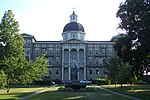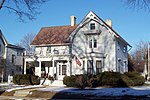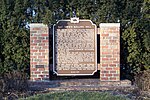Pio Nono College (Wisconsin)
1870 establishments in Wisconsin1972 disestablishments in WisconsinEducational institutions established in 1870Schools of education in Wisconsin
The Catholic Normal School and Pio Nono College, also known as Holy Family Normal School, was a paired institution (sharing the same faculty) in St. Francis, Wisconsin, which also included a high school component, founded in 1870 by Dr. Joseph Salzmann as the first Catholic normal school in the United States. The Normal School specialized in training young men in music education for Catholic boys' schools, while Pio Nono was a business school.
Excerpt from the Wikipedia article Pio Nono College (Wisconsin) (License: CC BY-SA 3.0, Authors).Pio Nono College (Wisconsin)
East Saint Francis Avenue,
Geographical coordinates (GPS) Address Nearby Places Show on map
Geographical coordinates (GPS)
| Latitude | Longitude |
|---|---|
| N 42.979722222222 ° | E -87.876388888889 ° |
Address
Thomas More High School
East Saint Francis Avenue
53235
Wisconsin, United States
Open on Google Maps






